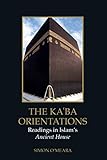The Kaʿba Orientations : Readings in Islam’s Ancient House / Simon O'Meara.
Material type: TextPublisher: Edinburgh : Edinburgh University Press, [2022]Copyright date: 2020Description: 1 online resource (264 p.) : 6 B/W illustrations 51 colour illustrations 1 B/W line artContent type:
TextPublisher: Edinburgh : Edinburgh University Press, [2022]Copyright date: 2020Description: 1 online resource (264 p.) : 6 B/W illustrations 51 colour illustrations 1 B/W line artContent type: - 9780748699308
- 9780748699315
- 297.352 23
- BP187.4
- online - DeGruyter
| Item type | Current library | Call number | URL | Status | Notes | Barcode | |
|---|---|---|---|---|---|---|---|
 eBook
eBook
|
Biblioteca "Angelicum" Pont. Univ. S.Tommaso d'Aquino Nuvola online | online - DeGruyter (Browse shelf(Opens below)) | Online access | Not for loan (Accesso limitato) | Accesso per gli utenti autorizzati / Access for authorized users | (dgr)9780748699315 |
Browsing Biblioteca "Angelicum" Pont. Univ. S.Tommaso d'Aquino shelves, Shelving location: Nuvola online Close shelf browser (Hides shelf browser)

|

|

|

|

|

|

|
||
| online - DeGruyter French and Spanish Queer Film : Audiences, Communities and Cultural Exchange / | online - DeGruyter Religion and Society in Scotland since 1707 / | online - DeGruyter The Making and Unmaking of Francoist Kitsch Cinema : From Raza to Pan's Labyrinth / | online - DeGruyter The Kaʿba Orientations : Readings in Islam’s Ancient House / | online - DeGruyter Gertrude Stein, Modernism, and the Problem of 'Genius' / | online - DeGruyter Freedom of Information in Scotland in Practice / | online - DeGruyter Commercial Arbitration : The Scottish and International Perspectives / |
Frontmatter -- Contents -- List of Figures -- Acknowledgements -- Introduction -- One: The Kaʿba as Qibla -- Two: The Kaʿba as Navel -- Three: The Kaʿba as Substructure -- Four: The Kaʿba as Beloved -- Five: The House as Holder -- Six: The House as Dwelling -- Conclusion -- Notes -- Bibliography -- Index
restricted access online access with authorization star
http://purl.org/coar/access_right/c_16ec
Explores the Kaʿba as it has been conceptualised, represented and used by Muslims from the earliest period of Islam onwardsThe first book-length exploration of the Kaʿba in a Western languageExplains what the Kaʿba is by examining how it functions architecturally and is represented culturallyEach chapter pursues a different aspect of the Kaʿba, presenting new findings and argumentsExtensively illustrated, including a number of rarely reproduced imagesWhat is the Kaʿba and why it is pivotal to the Islamic world? Why do pilgrims go about it, not in it? Is it empty? And why is a hollow building covered in black silk?The most sacred site of Islam, the Kaʿba (the granite cuboid structure at the centre of the Great Mosque of Mecca) is here investigated by examining six of its predominantly spatial effects: as the qibla (the direction faced in prayer); as the axis and matrix mundi of the Islamic world; as an architectural principle in the bedrock of this world; as a circumambulated goal of pilgrimage and a site of spiritual union for mystics and Sufis; and as a dwelling that is imagined to shelter temporarily an animating force; but which otherwise, as a house, holds a void.
Mode of access: Internet via World Wide Web.
In English.
Description based on online resource; title from PDF title page (publisher's Web site, viewed 20. Nov 2024)


